 I have been a collector my whole life. I started with baseball cards, then moved on to stereoview photographs of New York City. In fact, that’s how I wound up at Green-Wood the first time. Like all collectors, I would sometimes go to a show and not find what I was looking for. It then became a question of going home empty-handed or slightly expanding the scope of what I was collecting. As I looked for New York City views, I kept coming across views of some place called Green-Wood Cemetery. At one show, about 1982 or so, I decided to buy two stereoviews of Green-Wood, taken about 1860. I still remember one of those views–it showed snow on the ground and on the monuments. I think I paid $20 for it–quite a splurge back then. My first visit to Green-Wood was a result of these purchases. It occurred in 1986. I saw an ad for a tour, led by a professional photographer, of Brooklyn’s Green-Wood Cemetery. I wanted to go on the tour so that I could see the spots I knew from these old photographs. That first visit was an amazing experience–what a great place!
I have been a collector my whole life. I started with baseball cards, then moved on to stereoview photographs of New York City. In fact, that’s how I wound up at Green-Wood the first time. Like all collectors, I would sometimes go to a show and not find what I was looking for. It then became a question of going home empty-handed or slightly expanding the scope of what I was collecting. As I looked for New York City views, I kept coming across views of some place called Green-Wood Cemetery. At one show, about 1982 or so, I decided to buy two stereoviews of Green-Wood, taken about 1860. I still remember one of those views–it showed snow on the ground and on the monuments. I think I paid $20 for it–quite a splurge back then. My first visit to Green-Wood was a result of these purchases. It occurred in 1986. I saw an ad for a tour, led by a professional photographer, of Brooklyn’s Green-Wood Cemetery. I wanted to go on the tour so that I could see the spots I knew from these old photographs. That first visit was an amazing experience–what a great place!
Now, I collect of behalf of the Green-Wood Historic Fund. One of my great pleasures as Green-Wood Cemetery historian is to collect items pertaining to our permanent residents and the cemetery itself. We’ve collected some great things over the years, have had some great donations, and are constantly expanding our holdings.
I recently purchased the above photograph online. The seller noted he thought it was a photograph of a member of the 79th New York Infantry, known as the Highlanders, in uniform. He reported that the back of the carte de visite photograph had “McLellan” lightly pencilled on it. Based on that name, he had concluded that the image was likely Major David McLellan.
I had to do some quick research. I checked the best online source for information on Civil War soldiers, the American Civil War Research Database ($25 for a one year subscription) and found information about Major McLellan. He enlisted on May 29, 1861, at New York City, as a major, and was commissioned into the field and staff of the 79th on June 1. He was discharged on August 10 of that same year and died on July 24, 1867 at the age of 42. I checked the cemetery database and discovered a David McLellan was interred at Green-Wood on July 26, 1867. I then called Theresa LaBianca, the cemetery archivist, and asked her to check the cemetery records; she soon confirmed the David McLellan at Green-Wood was 42 years old, just like the major, and had died on July 24, 1867. A match!
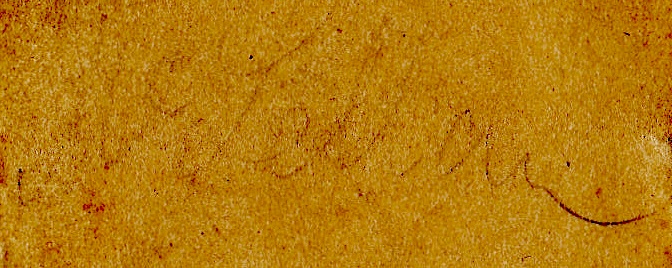 Now, the question was–was this a photograph of Major McLellan? Well, first of all, the backmark on the photograph identified the photographer as R.A. Lewis of 152 Chatham Street in New York City. That helped; enlisted in New York City, likely to have had his photograph taken in New York City before he went off to the front. Now, how about that light pencil mark on the back. Here it is, enhanced with my photo editing software. I think it does look like McLellan, so that’s good.
Now, the question was–was this a photograph of Major McLellan? Well, first of all, the backmark on the photograph identified the photographer as R.A. Lewis of 152 Chatham Street in New York City. That helped; enlisted in New York City, likely to have had his photograph taken in New York City before he went off to the front. Now, how about that light pencil mark on the back. Here it is, enhanced with my photo editing software. I think it does look like McLellan, so that’s good.
Now, how about what he’s wearing. Does that tell us that this is an officer with the 79th New York? Well, I think it does. There were many unusual regiments raised during the Civil War. There were German units, regiments of chaplains, regiments of tall men only, regiments of Scotsmen. The 79th New York Infantry actually was formed in 1859, before the Civil War, and was designated the 79th New York State Militia after the 79th Cameron Highlanders of the British Army. When the Civil War began, 1000 men, mostly Scots, Irish, and English, were recruited for service. The 79th, to say the least, wore a distinctive uniform, particularly early in the Civil War. The dress uniform consisted of black shoes with, according to Mark Lloyd in Combat Uniforms of the Civil War, “red-and-white checkered knee-length woolen socks;” in the right sock was placed a dirk, a short curved knife that proved tremendously handy in hand to hand combat. Now, here’s a detail of McLellan’s photograph (on the left) and here’s a drawing I found in Lloyd’s book, of the leg of a soldier in the 79th. Notice the shoes–they do look “uniform.” Also notice the sock McLellan is wearing–you do see the same checked pattern as in the red and white drawing at the right. And notice the dirk sticking out of the top of McLellan’s right sock; that was also part of the 79th’s uniform. The uniform of the men of the 79th also included kilts and a white hair sporran (Scottish Gaelic for “purse,” it served as a pocket). Kilts and a white hair sporran in the McLellan photo: check and check. Now, it appears that the men of the 79th also wore a Glengarry hat, traditionally boat-shaped. That is clearly not the case with McLellan. But, particularly early in the war, there was some free-lancing of uniforms, particularly by officers, which may explain the variation here.
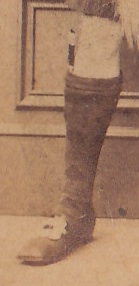
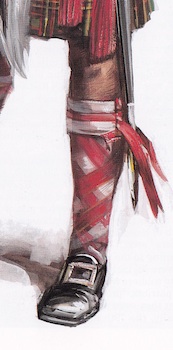
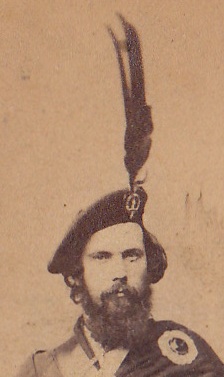 Let’s finish up with one more detail–Major McClellan’s face and that spectacular feather. Quite a look! Now, if this photograph was taken in 1861, when McLellan served with the 79th, he would have been about 36 years old then. That seems to work, I think.
Let’s finish up with one more detail–Major McClellan’s face and that spectacular feather. Quite a look! Now, if this photograph was taken in 1861, when McLellan served with the 79th, he would have been about 36 years old then. That seems to work, I think.
So, while it is not a certainty, I think this photograph is of Major David McLellan of the 79th New York Highlanders, taken early in the Civil War, in his uniform. A wonderful find!
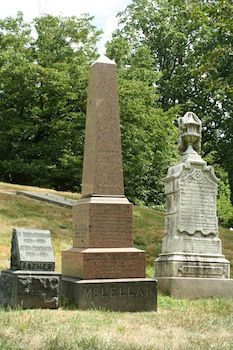
 UPDATE: I went out to Major McLellan’s gravesite today, July 9. Here’s a photograph of the McLellan family lot. Note the three McLellan gravemarkers. Strangely enough, both the pink granite obelisk in the middle and the marble monument at the right are dedicated to Major McLellan. It appears that the one at right, detail of which is shown here, was put there by his wife (“IN MEMORY OF MY DEAR BELOVED HUSBAND”) and that the granite obelisk, according to its inscription, was “ERECTED BY HIS FRIENDS TO” his memory. Here’s a close-up of the inscription.
UPDATE: I went out to Major McLellan’s gravesite today, July 9. Here’s a photograph of the McLellan family lot. Note the three McLellan gravemarkers. Strangely enough, both the pink granite obelisk in the middle and the marble monument at the right are dedicated to Major McLellan. It appears that the one at right, detail of which is shown here, was put there by his wife (“IN MEMORY OF MY DEAR BELOVED HUSBAND”) and that the granite obelisk, according to its inscription, was “ERECTED BY HIS FRIENDS TO” his memory. Here’s a close-up of the inscription.
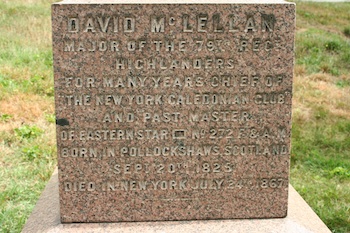
A very nice find , and I live in the area of Pollockshaws ,in Glasgow, Scotland
I like the history of the American Civil war ,and did not realise so many Scots or Irish were involved.
Keep up the good work
Hello, my name is Rachel Kelly, Im a collector and 79th New York Historian. The image you have is not of a 79th uniform. I own original 79th uniforms, have studied all known 79th relics in friends collections ect. The man pictured is wearing common civilian Scottish attire.of the 60s & 70s
For example, Robert Gair, Lawrence Beattie, and George Arnott of 3rd company show both the parade uniform and fatigue uniform. They wore regulation kepis for fatigue and blue glengarry bonnets with red/blue/white dicing.
http://photos-h.ak.fbcdn.net/hphotos-ak-ash2/25299_103291859708207_103289856375074_57189_1967029_n.jpg
Here is the medal of honor recipient’s bonnet in the collection.
http://photos-h.ak.fbcdn.net/hphotos-ak-ash2/24239_108859822484744_103289856375074_72666_1466037_n.jpg
The hats are just a small example of why this person is not a 79th soldier. It’s a fine example of the era’s enthic clothing though.
On a related note, I found your page through Greenwood research, as you say many Highlanders are buried there. I have images of a lot of them, and funeral acounts of some.
I would love to talk more about the 79th with you sir, I hope my post here had not created any sort of bad feelings!
-Rachel Kelly
Thanks for this information. I appreciate your comments. In retrospect, I think this blog post was inaccurate–thanks for the corrections.
Greetings,
In consulting my extensive database, and confirming it withe Grand Lodge of NY, it appears that Eastern Star Lodge No. 272 should actually read 227.
Regards.
Gary
Liverpool, NY
The sporran he is wearing is a horse hair regimental one and the six tassels denote it is an Argyll and Sutherland Highlanders sporran. That regiment was based at Stirling Castle in Scotland. However the Argylls were formed in 1881. They were established by the amalgamation of the 91st and 93rd Highland regiments. The 93rd also had six tassels on their sporran. That regiment were raised in 1799.
Lastly the knife in the sock is a Sgain Dhu, (the black knife) not a dirk. He is wearing a dirk, short sword, on his belt, on his right side. Hope that is helpful.
Thanks, Mark, for sharing your expertise on this. Soon after I wrote this blog post, I realized it was not my finest hour of research. Glad you are able to help us interpret what we see in this photograph.